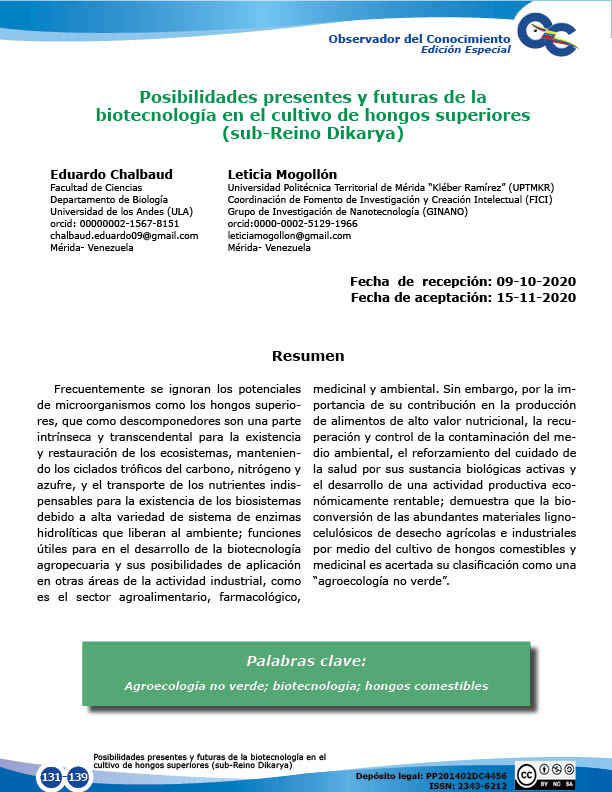Posibilidades presentes y futuras de la biotecnología en el cultivo de hongos superiores (sub-Reino Dikarya)
Keywords:
non-green agroecology; biotechnology; edible mushroomsAbstract
Frequently the potentials of microorganisms such as higher fungi are ignored, which as decomposers are an intrinsic and transcendental part for the existence and restoration of ecosystems, maintaining the trophic cycles of carbon, nitrogen and sulfur, and the transport of essential nutrients for the existence of biosystems due to the high variety of hydrolytic enzyme system that they release into the environment; useful functions for the development of agricultural biotechnology and its application possibilities in other areas of industrial activity, such as the agri-food, pharmacological, medicinal and environmental sectors. However, due to the importance of its contribution in the production of foods of high nutritional value, the recovery and control of environmental contamination, the reinforcement of health care due to its active biological substances and the development of an economically productive activity. profitable; shows that the bioconversion of the abundant lignocellulosic agricultural and industrial waste materials by means of the cultivation of edible and medicinal mushrooms is correct its classification as a “non-green agroecology”.
Downloads
References
AJITH, T. A., & JANARDHANAN, K. K. (2007). Indian medicinal mushrooms as a source of antioxidant and antitumor agents. Journal of Clinical Biochemistry and Nutrition, 40(3), 157.
BERMÚDEZ, R., MORRIS, H., DONOSO, C., MARTÍNEZ, C., & RAMOS, E. (2003). Influencia de la luz en la calidad proteica de Pleurotus ostreatus, var. florida. Rev Cub Invest Biomed, 22, 226–31.
BONATTI, M.; KARNOPP, P.; SOARES HM, F. (S/A). Evaluation of Pleurotus ostreatus y Pleurotus sajor-cajur nutricional characteristics when cultivated in differents lignocellulosic waste. Food Chem 2004; 88:125-428.
CANO-ESTRADA, A., & ROMERO-BAUTISTA, L. (2016). Valor económico, nutricional y medicinal de hongos comestibles silvestres. Revista chilena de nutrición, 43(1), 75-80.
CHALBAUD, E. (2015). Caracterización taxonómica y fisiológica de cepas de “setas” (género Pleurotus) pertenecientes al cepario del Laboratorio de Biotecnología de microorganismos SIXTO DAVID ROJO, Tesis de Pregrado. Universidad de Los Andes-Facultad de Ciencias, Departamento de Biología, Venezuela p. 92.
DEMNEROVÁ, K., MACKOVA, M., SPEVÁKOVÁ, V., BERANOVA, K., KOCHÁNKOVÁ, L., LOVECKÁ, P., RYSLAVÁ, E. & MACEK, T. (2005). Two approaches to biological decontamination of groundwater and soil polluted by aromatics—characterization of microbial populations. International Microbiology. 8:205-211
DÍAZ, A. (2016). Cultivo del Hongo Pleurotus ostreatus en Concha de Cacao. Tesis de Pregrado. Universidad de Los Andes-Facultad de Ciencias, Departamento de Biología, Venezuela p. 64.
GUERRERO, B., MORILLO, O., CARRERO, C. Y CHALBAUD, E.(2013). El Hongo Pleurotus ostreatus Alternativa Nutricional para Comunidades Agroecologícas y Herramienta Pedagógica en la Enseñanza de la Biología. Revista de la Sociedad Venezolana de Microbiología. 33: 129-133.
GUZMÁN, G., MATA, G., SALMONES, D., SOTO-VELAZCO, C., & GUZMÁN, L. (1993). El cultivo de los hongos comestibles: con especial atención a especies tropicales y subtropicales en esquilmos y residuos agro-industriales. Instituto Politécnico Nacional.
GUZMÁN, G. (1998). Análisis cualitativo y cuantitativo de la diversidad de los hongos de México (Ensayo sobre el inventario fúngico del país). La Diversidad Biológica de Iberoamérica, II Volumen Especial, 111–175.
JUSTO, MB.;GUZMÁN G.;MEJIA E.G.; DÍAZ, C.; Martínez G.; CORONA E. (1998). Composición química de tres cepas mexicanas de setas Pleurotusostreatus. Arch Latinoam Nutr. 1998; 48(4):359-63.
MALLOCH, D.; PIROZYNSKI, K.; & RAVEN, P.(1980). Ecological and evolutionary significance of mycorrhizal symbioses in vascular plants (a review). Proceedings of the National Academy of Sciences, 77(4), 2113–2118.
MERCADO, R. (1995). Producción por fermentación en medio sólido de xilanasa de Pleurotus ostreatus crecido sobre bagacillo de caña. Tesis de Maestría. Universidad de Los Andes-Facultad de Ciencias-Postgrado en Biotecnología de Microorganismos. Venezuela p. 112
MOORE-LANDECKER, E. (1996). Fundamentals of the Fungi (4 edition). Upper Saddle River, N.J: Benjamin Cummings.
MURCIA, M. A., MARTÍNEZ, M., JIMÉNEZ, A. M., VERA, A. M., HONRUBIA, M., & PARRAS, P. (2002). Antioxidant activity of edible fungi (truffles and mushrooms): losses during industrial processing. Journal of Food Protection®, 65(10), 1614–1622.
PALM, M., & CHAPELA, I. (1998). Mycology in Sustainable Development: Expanding Concepts, Vanishing Borders. North Carolina.: Parkway, Boone.
PÉREZ, D. (2019). Produccion de inoculos liquidos del hongo Pleurotus ostreatus utilizando como sustrato Cajanus cajan (frijol quinchoncho). Tesis de Pregrado. Universidad de Los Andes-Facultad de Ciencias, Departamento de Biología, Venezuela p. 72.
RONCERO-RAMOS, I. (2015). Centro Tecnológico de Investigacion del Chapiñon de la rioja (CETICH) ed. Propiedades Nutricionales y saludables de los hongos, p 12-23.
ROUSSOS, S.; BRESSON, E.; SAUCEDO-CASTAÑEDA, G.; MARTINEZ, P.; GUINBERTEAU, J. y OLIVIER, J. (1997). Production of mycelial cell inoculum of Pleurotus opuntiae on natural support in solid state fermentation. In Advances in Solid State Fermentation (pp. 483–500). Springer.
SÁNCHEZ, C. (2004). Modern aspects of mushroom culture technology. Applled Microbiol Biotecnol; 10:1-15.
SÁNCHEZ, J., & ROYSE, D. (2001). La biología y el cultivo de Pleurotus spp. ECOSUR/LIMUSA.
SIFUENTES, E. (2014). Producción de inóculo de Pleurotus ostreatus para uso en biorremediación de suelos contaminados con hidrocarburos de petróleo, Tesis de Pregrado. Universidad Nacional Agraria La Molina. Facultad de Ciencias, Perú p. 75.
VEDDER, P. (1986). Cultivo Moderno del Champiñon. Madrid España: Editorial Mundi-Prensa.
ZHANXI, L. (2005). Juan-Cao Tecnology. In Mushroom Growers Handbook 1: Oyster Mushroom Cultivation. (Vol. 1, pp. 110–1161). República de Korea: MushWorld.

Downloads
Published
How to Cite
Issue
Section
License

This work is licensed under a Creative Commons Attribution-NoDerivatives 4.0 International License.







